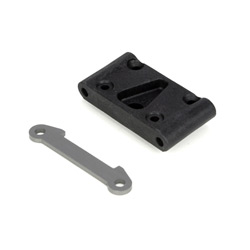 One of the unique features of the 22 and 22T is that you can adjust front kick. The 22 comes with 20 and 25 degree kick shims while the 22T comes with a complete 30 degree kick pivot. We envision many drivers trying more kick on their 22 with the release of the 22T's 30 degree front pivot. If you own a 22 and want to try 30 degree kick you will need the following part. When using the 30 degree pivot do not use the pivot shims included with the 22.
One of the unique features of the 22 and 22T is that you can adjust front kick. The 22 comes with 20 and 25 degree kick shims while the 22T comes with a complete 30 degree kick pivot. We envision many drivers trying more kick on their 22 with the release of the 22T's 30 degree front pivot. If you own a 22 and want to try 30 degree kick you will need the following part. When using the 30 degree pivot do not use the pivot shims included with the 22.
Here is a technical article with a great and simple conclusion at the end to help all of us understand how kick changes vehicle dynamics. Increasing kick on a 2wd platform (kick effects 4wd slightly different due to the front drive) will predominately place more weight on the rear of the vehicle. The increase angle relative to the horizontal also absorbs sharp edge bumps as the kick angle serves as an auxiliary suspension and allows the front wheels to move rearward thus shortening the wheelbase. Think of more kick as almost like a break-away front end. This is why more kick is always better in the bumps. There is one caveat though. More kick will induce a more active weight transfer. The reduction in wheelbase as the front suspension compresses will result in a more aggressive weight transfer over the front; it just takes more force to get the suspension to that point compared to less kick. You can visualize the front wheels sweeping backward and the frontend of the car protruding over the front wheels more so as kick angle increases, but as I said, it just take more force to get the front suspension to that point. Front kick can be thought of as “front anti-squat”, but there are some hidden phenomenon that can be challenging. 2wd cars have historically always had more kick over 4wd cars as they need more weight transfer to develop grip, and there no front brakes or massive front weight transfer that would play into the negatives of having more kick.
In conclusion, more kick yields more rear grip, absorbs sharp edge bumps more readily, but will transfer weight more aggressively if forces are available to compress the front suspension. Less kick transfers weight at a slower rate, sacrifices in the choppy bumps, but drives flatter around the track.
------------------------------------------------------------------------------------
What will more or less caster give you?
I always consider caster to be similar to trail on a bike fork. Increasing the caster (or trail) reduces the car's immediacy of response to any change in direction from a steering input.
So increased caster will 'numb' the initial steering response into the corner but will make the car not want to straighten up when coming out of the corner.
Reduced caster will do the opposite - it will make the car feel more immediate to any given steering input - so it will feel twitchier on the way into a corner but will release the turn earlier when you straighten up.
Whilst this was obviously written for the 22 and 22T, obviously physics and dynamics are universal and thus it would equally apply to other cars.
Andy Carter
